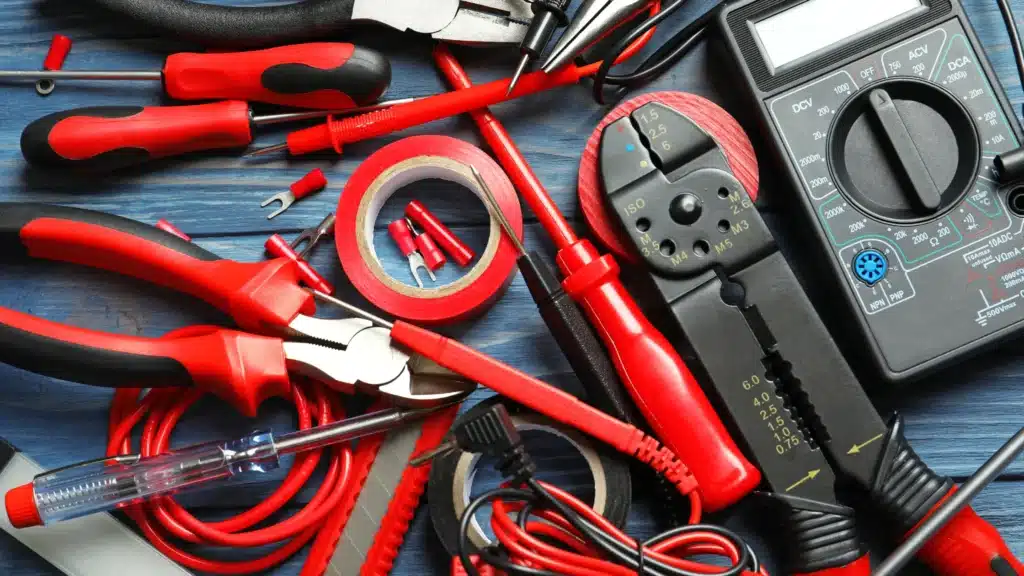Did you know that over 700,000 electricians, engineers, line installers, and workers light up our lives by keeping the power flowing in homes and businesses across the country with electrical technology? It’s not just about fixing outlets; what electricians, line installers, and electrical engineers do encompasses a vast array of tasks in their occupations – from installing complex wiring systems to troubleshooting blackout causes with advanced electrical technology. These unsung heroes, many electricians including experienced and master electricians, dive into the world of volts and amps with their electrical technology so we don’t have to, making sure our daily gadgets and gizmos keep buzzing without a hitch. So next time you flip a switch or plug in your charger, remember there’s a whole profession of many electricians, including maintenance electricians and master electricians, dedicated to ensuring that simple action works like magic every single time, thanks to how electricians install and maintain our electrical systems.
Electrician Job Overview
Daily Tasks
Electricians, as occupational employment workers, have a packed day of labor ahead of them in their occupations when they start their work. Their main job as maintenance electricians is to inspect electrical systems and equipment in schools, among other occupations for workers. This means checking if everything is working as it should, including the state and percent of information that may be involved. They look for any signs of damage or wear.
After inspection, electricians, a key occupation in the field of occupational employment, move on to installing and maintaining wiring and lighting systems, tasks that significantly influence their wages. Workers lay down new wires, set up lights, and make sure everything is connected correctly, keeping a tab on employment projections. It’s crucial that workers in various occupations follow safety standards to prevent hazards in their employment.
Troubleshooting electrical issues may be another big part of their job, occupations, and employment. When something goes wrong, electricians, workers in this occupation, may need to find the problem fast. Workers use their knowledge of electrical information in their occupations to fix issues without delay, which may enhance their employment opportunities.
Work Environment
An electrician’s work environment, like that of many occupations, may vary greatly from day to day. Most times, workers in these occupations may work indoors where it’s safe from harsh weather conditions. But occasionally, workers in their occupation may have to brave the outdoors regardless of rain or shine for employment.
Working as an electrician comes with its risks too—like the risk of electrical shocks and burns. Safety gear helps protect them from these dangers.
Workers in this occupation may often find themselves in cramped spaces trying to reach wires or at heights fixing light fixtures. It’s not always comfortable, but getting the job done safely is what matters most for workers in their occupation and employment.
Physical Demands
The physical demands on an electrician, a key occupation for many workers, are high but may be manageable with proper training and care. Frequent standing for long periods isn’t uncommon in this line of occupation and employment, and may occur often. Climbing ladders or scaffolding happens almost daily in many occupations because employment tasks may require reaching high places. Lifting heavy objects also comes with the employment territory; sometimes alone, other times with help depending on how heavy it may be.
Manual dexterity may play a significant role in an electrician’s ability to do their job well. Good eye-hand coordination may help them handle tools precisely while focusing on details. Being able to differentiate wire colors quickly may is essential for safe installations and repairs.
Skills and Qualifications
Education and Training
Electricians may need a strong foundation in education and training to succeed. Most begin with a high school diploma or equivalent, followed by technical schooling or an apprenticeship, and may include additional certifications. Apprenticeships may combine paid on-the-job training with classroom instruction.
Technical schools may offer courses related to electrical theory, blueprint reading, safety practices, and the National Electrical Code. After completing these programs, graduates may often enter apprenticeships for hands-on experience.
Licensing
In most states, electricians must obtain a license to work independently. This process usually involves passing an exam that covers electrical theory, the National Electrical Code, and local electric and building codes. Requirements vary by state but typically include several years of experience under supervision.
Some states have reciprocal licensing agreements allowing electricians licensed in one state to work in another without retesting. This mobility can be beneficial for finding work across different regions.
Certifications
Beyond licensing, electricians can pursue voluntary certifications from various organizations. These certifications showcase expertise in specific areas like solar panel installation or energy efficiency.
To maintain certification, electricians often need continuing education credits. This requirement ensures they stay updated on the latest technologies and codes.
Important Qualities
Electricians must possess certain qualities to excel at their jobs. Attention to detail is crucial for safety and code compliance when installing or repairing electrical systems. Problem-solving skills are essential for diagnosing complex electrical issues quickly. Dependability is key since clients rely on timely project completion.
Electrician’s success hinges on both hard skills learned through education and soft skills developed over time.
While formal education lays the groundwork, real-world experience sharpens these abilities.
Types of Electricians
Specializations
Electricians are not all the same. Many electricians choose to specialize, focusing on specific settings or types of work. This specialization affects the nature of their daily tasks.
Residential electricians primarily work in homes and apartments. They install wiring systems, fix electrical problems, and ensure that lighting works perfectly in living spaces. Their job is crucial for keeping our homes safe and well-lit.
Commercial electricians have a different focus. They operate in businesses, schools, hospitals, and other large buildings. Their projects are often larger than those of residential electricians. These experienced professionals must understand complex electrical systems to maintain safety and efficiency in these environments.
Industrial electricians stand apart due to their work environment – factories and industrial plants. Here, they deal with high-voltage systems and machinery that require specialized knowledge. Industrial settings pose unique challenges that only highly skilled industrial electricians can tackle effectively.
Roles and Responsibilities
Regardless of their specialization, all electricians share some common roles and responsibilities.
Before starting any project, reading blueprints or technical diagrams is essential for an electrician’s success on the job site. These documents contain critical information about electrical circuits, which guides them throughout their work process. This skill ensures they can accurately install new systems or repair existing ones without errors.
Installing new electrical systems is a significant part of an electrician’s job. They lay out wiring through walls, connect it to power sources, and make sure everything functions correctly before finishing up. But installation isn’t where it ends; repairing old systems also falls under their purview. Whether it’s fixing a short circuit or replacing damaged wires, these tasks keep electricians busy ensuring our access to electricity remains uninterrupted.
Moreover, ensuring all work meets legal standards and building codes is paramount for every task they undertake. This responsibility means staying updated on regulations and applying them meticulously during each project phase. By doing so, electrical contractors protect clients against potential hazards while maintaining the integrity of buildings’ electrical infrastructures.

Tools and Equipment
Electricians use a variety of tools and equipment to do their job. These help them install, repair, and maintain electrical components safely and efficiently.
Common Tools
Multimeters are essential for electricians. They measure voltage, current, and resistance. This helps in diagnosing problems. For example, if a lighting fixture isn’t working, an electrician might use a multimeter to check for power supply issues.
Wire strippers are another key tool. Electricians use these to remove insulation from wires without damaging them. This is crucial when connecting wires or adding new fixtures.
Conduit benders shape metal tubing that protects wiring in construction projects. They ensure the conduit fits precisely along walls or ceilings. This makes installations look neat and professional.
Safety Gear
Safety is paramount for electricians due to the risks involved with electricity. Insulated gloves protect hands from shocks while handling live wires or electrical components. Protective eyewear guards against flying debris when cutting wire or drilling into walls. Hard hats are necessary on construction sites where falling objects pose a risk. Safety harnesses prevent falls when working at heights, such as installing lighting on tall buildings.
Electricians must be prepared with both common tools and safety gear no matter the task—be it setting up new lighting fixtures or repairing existing electrical systems in homes or commercial buildings. Their toolkit allows them to tackle various challenges safely and effectively.
Typical Workday
Tasks and Duties
Electricians start their day with a clear plan. They map out the layout for electrical wiring based on job specs. This requires understanding blueprints and safety codes. It’s not just about drawing lines; it involves critical thinking.
Next, they get hands-on by connecting wires to crucial components like circuit breakers and transformers. Precision is key here. A small mistake can mean big problems later.
Testing electrical systems is another major task. Electricians use tools like ohmmeters and voltmeters to ensure everything works right. These tools were mentioned before when discussing equipment electricians use daily.
Work Locations
Electricians work in various places, from cozy homes to bustling businesses. Construction sites are common too, where they lay down the framework for future wiring.
They often travel between multiple job sites in a day. This means their work is not just confined to one location but spread across several.
Working in confined or elevated spaces comes with the territory too. It’s part of what makes being an electrician both challenging and exciting.
Advancement Opportunities
Career Pathways
Electricians start their careers through apprenticeship programs. These programs combine on-the-job training with classroom instruction. They usually last four to five years. After completing an apprenticeship, electricians become journeymen by passing exams.
Journeymen have more responsibilities than apprentices. They can work independently and lead projects. With further experience and additional exams, journeymen can achieve master electrician status. Master electricians oversee entire projects and may run their own businesses.
Further Education
To stay ahead in the field, electricians need continuous learning. Continuing education courses are crucial for them to keep up with new codes, safety procedures, and technological advancements.
Electricians often pursue advanced training in specialized areas like renewable energy systems or smart home technology. This specialization opens up new job opportunities and higher earning potential.
Injuries and Illnesses
Working as an electrician comes with its risks including cuts, falls, burns, and shocks.
Most injuries are nonfatal but may require time off for recovery.
There’s also a risk of chronic health issues from long-term exposure to high voltage.
Despite these risks, many find the rewards of being an electrician worth it.
Health and Safety
Injuries and Illnesses
Electricians face various risks on the job. Safety training is crucial. They have regular sessions to stay updated with industry standards. This helps them tackle new challenges safely.
Wearing personal protective equipment (PPE) is a must. Helmets, gloves, and boots protect them from electric shocks and other injuries. It’s all about minimizing risks.
Following safety protocols when dealing with live electricity is non-negotiable. A single mistake can lead to severe injuries or worse. That’s why strict adherence to these rules is essential for every electrician.
Preventive Measures
The pay structure for electricians varies by sector—residential, commercial, or industrial. Each has its own set of demands and safety concerns.
Overtime pay becomes common during tight deadlines or emergencies in homes or businesses. This compensates for the extra hours worked under potentially hazardous conditions.
Experience, specialization, and location influence pay increases as well.
Electricians gain more skills over time.
Specializing in areas like solar energy may boost their income.
Working in regions with high demand for electrical work also leads to higher wages.
Job Market Outlook
Salary and Pay
Electricians often find work with electrical contractors or take the self-employment route as independent contractors. This flexibility allows them to choose projects that suit their skills and preferences. A significant number also secure positions in manufacturing, government services, or employment services sectors. These varied opportunities reflect the broad applicability of their skills across different industries.
The demand for electricians remains steady, primarily due to the ongoing need for maintenance of existing electrical infrastructure. Buildings old and new require regular checks and updates to ensure safety standards are met, especially following discussions on health and safety in previous sections. This necessity ensures a consistent flow of work for those in the field.
Employment Statistics
The future looks bright for electricians thanks to an expected employment growth driven by a construction boom and an increasing demand for alternative energy sources like solar power installations. As more buildings go up, so does the need for skilled professionals who can wire them safely and efficiently.
Retrofitting older buildings with updated electrical systems is another area contributing significantly to job growth prospects. With advancements in technology, many structures need overhauls to accommodate modern electrical demands—ensuring electricians stay busy updating systems to meet current standards.
Projected Growth Rate
Advancements in smart home technology have spiked demand for specialized skills related to automation systems installation, repair, and maintenance tasks associated with integrating Internet of Things (IoT) devices into residential settings. Electricians adept at navigating these complex networks will find themselves highly sought after as homes become increasingly connected.
Furthermore, there’s growing importance placed on energy efficiency which leads towards more jobs installing energy-saving lighting fixtures & motion sensors. As society pushes towards greener living spaces, electricians play a crucial role in making buildings more sustainable through innovative solutions that reduce power consumption.
Future of Electricians
Emerging Technologies
The electrician profession is on the brink of a significant shift. This change comes from both the expansion in the construction sector and an increased focus on renewable energy. As society leans more towards sustainability, electricians find themselves at the heart of this transformation. They are not just dealing with electrical wires anymore but also with cutting-edge technologies like solar panels and smart home systems.
For junior electricians, this evolution presents a golden opportunity. The aging workforce in this field needs fresh faces ready to take up the mantle. However, it’s not just about stepping in; it’s about adapting and growing with technological advancements. Continuous learning has become a staple for professionals within this field to stay relevant.
Job Outlook
Electricians enjoy diverse opportunities across various sectors, thanks to constant technological advancements and societal shifts towards sustainability. Whether you’re a maintenance electrician or interested in becoming one of the many PV installers, there’s promising job security ahead.
However, advancing your career as an electrician requires more than just basic knowledge of electrical technology and electrical code compliance; it demands continuous professional development. Staying abreast of emerging trends ensures that you can keep pace with innovations shaping your trade.
Despite its physical demands and potential risks, proper training and strict adherence to safety measures pave the way for a fulfilling career path within this essential trade. Electricians play a crucial role in building safer communities by ensuring that power systems work efficiently without posing hazards.
Final Remarks
Electricians light up our world, literally. From ensuring our homes are cozy and bright to keeping industries running smoothly, their role is indispensable. We’ve journeyed through what it takes to be an electrician—the skills, the tools, the daily grind, and even peeked into their future. It’s clear that this profession isn’t just about wires and circuits; it’s about problem-solving, innovation, and safety at its core. With technology evolving, electricians remain at the forefront of an electrifying future. Ready to spark a change in your career or know someone who is? Dive into the world of electricians. It’s more than just a job; it’s about powering dreams and lighting up lives. Let’s not keep this enlightening info to ourselves—share it with a friend or two. Who knows? You might just be the beacon they need.
Frequently Asked Questions
Electricians are like the superheroes of our homes and buildings, making sure electricity flows safely and efficiently. They install, maintain, and repair electrical systems to keep our lights on and gadgets running smoothly.
Becoming an electrician isn't just about handling wires; it's also about being a sharp problem-solver with solid math skills. Plus, you'll need good hand-eye coordination and the ability to distinguish colors accurately for wiring tasks.
Absolutely! Electricians can specialize in areas like residential services, commercial buildings, or even industrial settings. Think of it as choosing your own adventure within the electrical world.
Imagine Batman's utility belt but for fixing electrical issues. Every electrician needs reliable hand tools like pliers and screwdrivers, plus voltage testers and more advanced gadgets to diagnose problems in today’s tech-filled world.
A typical day? There's no such thing! One day you might be installing lighting in a cozy café; the next could find you troubleshooting an industrial generator. It’s all about variety and solving puzzles that keep things powered up.
Indeed they can! Starting as apprentices, they can climb up to journeyman status before reaching master level. Some even run their own businesses or become inspectors—there’s always room at the top!
Safety first is the motto here. With proper training on health standards plus protective gear (think helmets and gloves), risks are minimized. It's all about knowing your stuff and staying protected against potential hazards.

